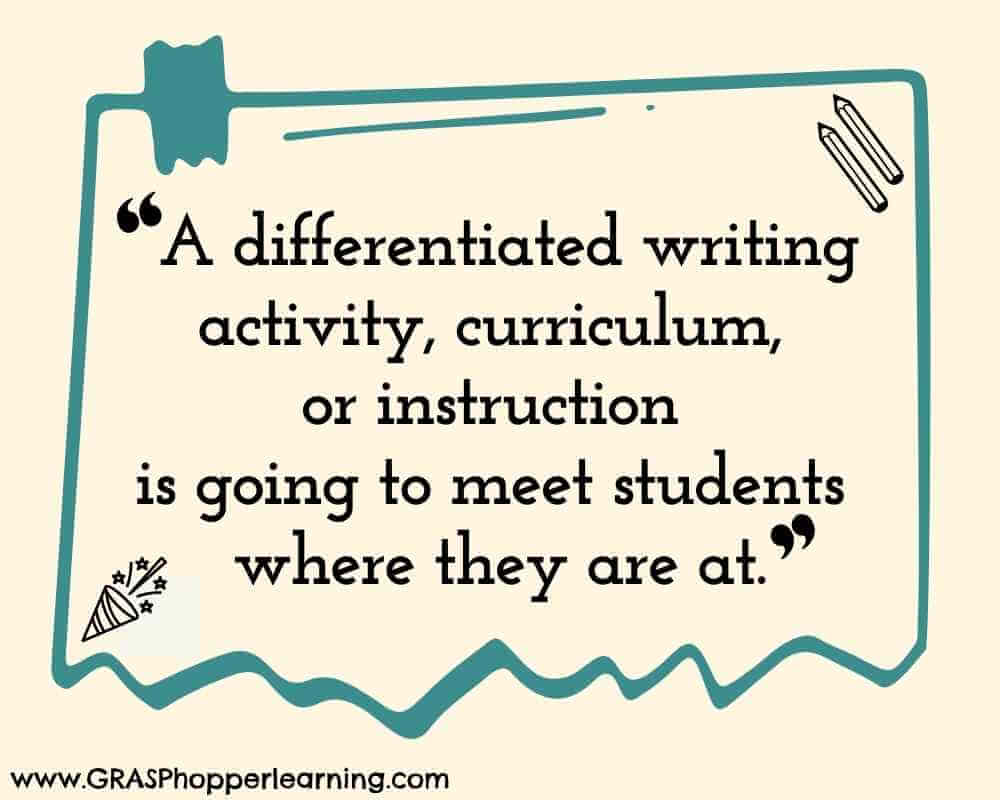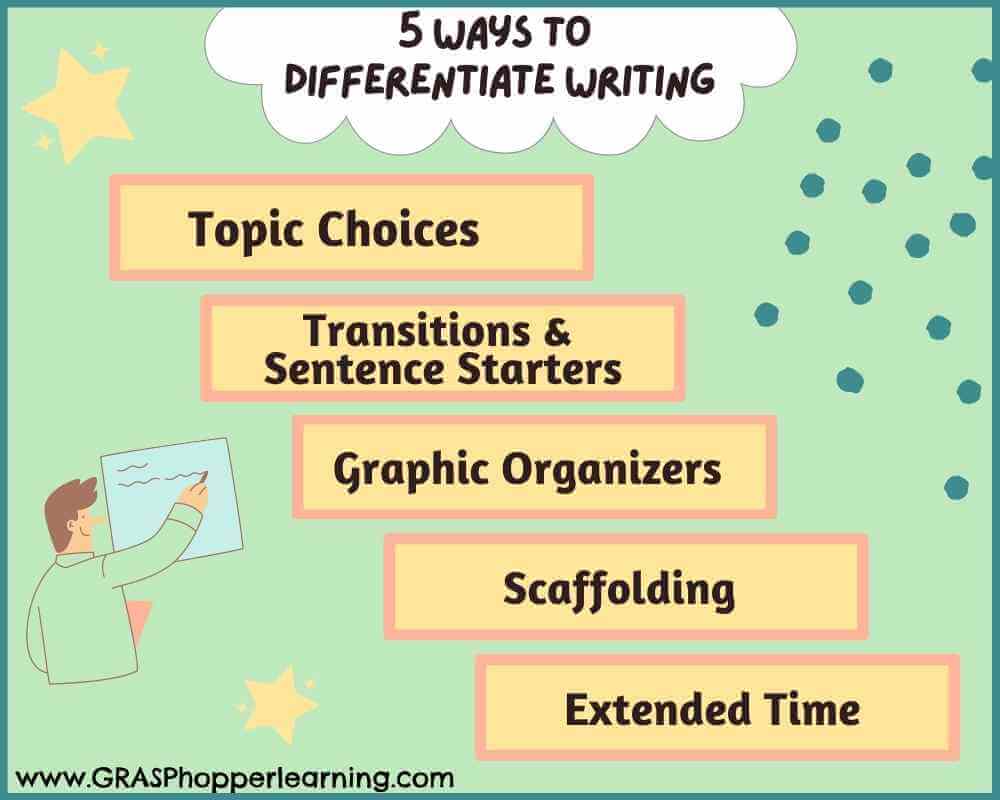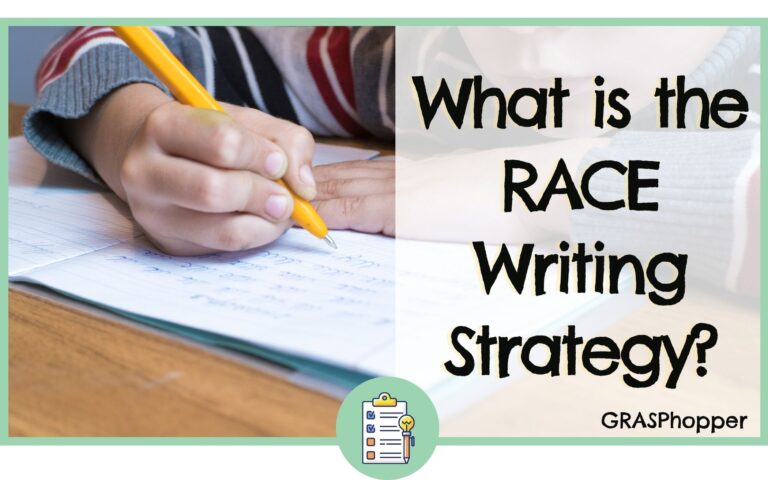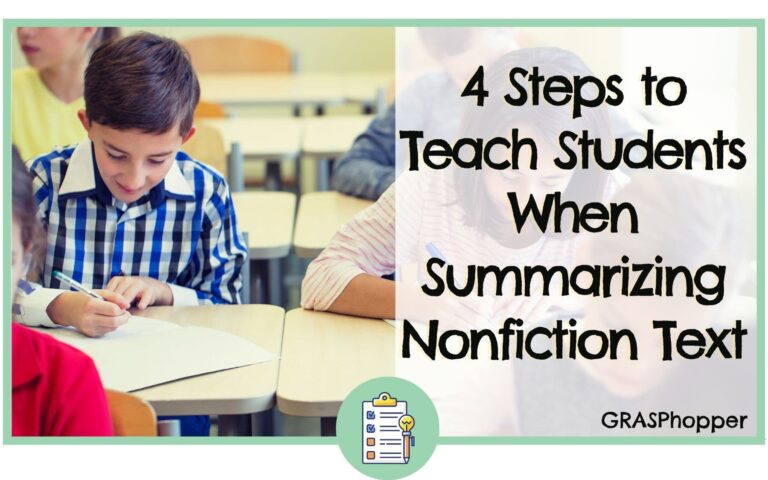When we first started working with students, we were shocked by some of the struggles with writing our students had. Sure, we learned about differentiation in college, but no one really can prepare you for the wide range of strengths and abilities in your classroom!

What are differentiated writing instruction strategies?
Differentiation is a big word that gets thrown around a lot. So, what does differentiated writing instruction actually mean? As you teach and assess students, you probably start to notice different needs, abilities, and struggles with writing of your students. This can feel really overwhelming when you have a class of 25+ students or a large group, and you’re wondering how in the world you can meet all their needs.
Enter differentiation. It is the answer to meeting those needs. A differentiated writing activity, curriculum, or instruction is going to meet students where they are at. It won’t force the same lesson on every student, or make every student learn at the same pace. Instead, it will allow for flexibility. It keeps everyone on the same path, but we may not be walking together. Make sense?
This might look like giving additional instruction or review for some students who have difficulty with writing. It might be giving additional time for writing or learning. It might mean bringing in different resources, prompts, activities, or supports to either supplement gaps or challenge students who have mastered the content.
Why is differentiation important in writing instruction?
If we know that differentiation is supposed to meet students where they are at, and that it allows for flexibility in instruction, maybe you can already start to see some benefits. The big one for us, that always has us excited about differentiation, is accessibility! Differentiated writing instruction strategies allow students to access the curriculum in different ways.

For example, we have had students who struggle with writing because their native language is not English. Totally makes sense! To make writing accessible, we would give them images with word captions, sentence stems, or story cubes. This gave the students an opportunity to learn writing and participate in the activities, without feeling stressed or frustrated.
Differentiated writing instruction also allows for maximization of each student’s growth in writing. This applies to both a student who struggles with writing and those who are on-level or mastering content. If we only present content at one level, then some students will never catch up (because they don’t get needed support), and some will stay behind (because they were capable of displaying more than the level given).
How do I differentiate my writing instruction?
Alright, we have explored the nitty-gritty of what differentiation is. Now, how do you make it happen? There are five areas we focus on when differentiating for our students. They are topic choices, transition words/sentence starters, graphic organizers, scaffolding, and allowing more time. Let’s explore each of these:
Topic Choices
You can differentiate in your writing instruction strategies by simply providing your students with multiple choices for their writing topics. This has really helped with our students who struggle to initiate writing, as it takes the guesswork out of what to write about. Sometimes when we just say to our students, “Write about something that happened to you”, their eyes go wide and you wonder if maybe you grew two heads (because they sure are looking at you funny). These struggles with writing are real. Their heads go down, and they spend the next writing period getting nothing done. Instead…
You can also do something that sounds kinda wild – but we promise it works: let you students create their own topics! Of course, you want to provide the support and scaffolding to make sure the topic works for the writing genre or assignment, but this is a great way to build in choice and differentiation.
Transitions Words and Sentence Starters
This is a go-to strategy in our classrooms. Giving your students sentence starters and transition word choices is an effective way to differentiate. Even students who don’t struggle with writing can use these when introduced to a new concept. Sentence starters gives your students a place to, well, start! And transition words can help your students move between ideas once they have begun.
For example, when working on personal narratives last year, we gave students the starting prompt, “Once upon a time…”. It was a little cheesy (we agree), but many of our students are familiar with that-company-that-shall-not-be-named and their movies! It helped them just start writing and get something down.
Graphic Organizers
We love using graphic organizers because many students cannot simply sit down and churn out a paragraph – even when they have ideas, sentence starters or examples. A graphic organizer breaks down the concept, almost like a step-by-step. We also like to include question prompts within the graphic organizers for some students who have difficulty with writing, that may need reminders along the way. One big tip with organizers – make sure to spend some time teaching how to use them, before expecting them to be completed. Many times we hand our students amazing differentiated resources, without realizing they have no clue how to use them successfully.

Scaffolding
If you’ve ever listened to instructions or a story, and gotten lost half-way through (that’s us at every PD session. sorry, principal!), then you know the importance of scaffolding. Instead of throwing all the info at our students, we need to break it down into sizable chunks – then add more when our students have mastered the concept. And because we are differentiating, students can build and move up at different paces!
Allowing More Time
Lastly, give students time. When we do writing assignments in class, we have students who finish like *snap* that! And some who may need two class periods. Do what is best for your students, and allow for time with students who have struggles with writing. We know this can be tough because the curriculum has to move at a certain pace – think about ways you could also modify the word, maybe have students who need more time write one less example, or have someone scribe for them some of the time. For your quick students? Always have something prepared – an extension activity or teacher group – that you can use while other students work.
Ready to bring differentiated writing instruction to your classroom?
We know that creating differentiated lessons can be time consuming, so we included everything you need in our writing resources – video mini-lessons, anchor charts, differentiated activities and more. So you just have to focus on teaching.
Check out the Sentence Writing Differentiated Bundle that is great for 1st-3rd grade students. It contains five differentiated writing activities (and growing!), including Foundational Sentence Writing, along with Capitalization and Punctuation activities.
We also have a Paragraph Writing Differentiated Bundle that we recommend for 3rd – 6th grade. This resource is a lifesaver as you transition to essay writing. We gave leveled resources to teach topic sentences, supporting details, concluding sentences, and more. Seriously – it will save you a headache (or ten). And those struggles with writing will fade.

The good news is, you don’t have to come up with all the differentiated writing activities yourself. Like we said – we live and breath differentiated instruction. Grab these resources and help a student who struggles with writing in your class!











